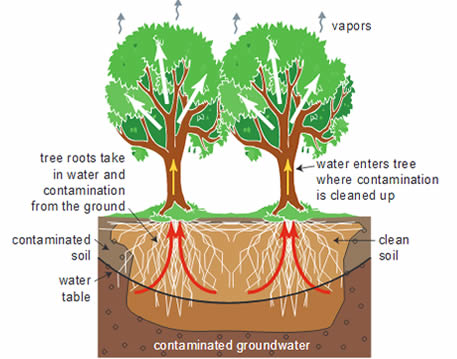Below are excerpts taken from EPA publication: Guide to Phytoremediation
Phytoremediation uses plants to clean up contaminated environments. Plants can help clean up many types of contaminants including metals, pesticides, explosives, and oil. However, they work best where contaminant levels are low because high concentrations may limit plant growth and take too long to clean up. Plants also help prevent wind, rain, and groundwater flow
from carrying contaminants away from the site to surrounding areas or deeper underground.
How Does It Work?
Certain plants are able to remove or break down harmful chemicals from the ground when their roots take in water and nutrients from the contaminated soil, sediment, or groundwater. Plants can help clean up contaminants as deep as their roots can reach using natural processes to:
• Store the contaminants in the roots, stems, or leaves.
• Convert them to less harmful chemicals within the plant or, more commonly, the root zone.
• Convert them to vapors, which are released into the air.
• Sorb (stick) contaminants onto their roots where very small organisms called “microbes” (such as bacteria) that live in the soil break down the sorbed contaminants to less harmful chemicals.
How Long Will It Take?
Phytoremediation may take several years to clean up a site. The cleanup time will depend on several factors. For example, phytoremediation will take longer where:
• Contaminant concentrations are high.
• The contaminated area is large or deep.
• Plants that have a long growing time are used.
• The growing season is short.
These factors vary from site to site. Plants may have to be replaced if they are damaged by extreme weather, pests, or animals. This also will add time to the cleanup.
Why Use Phytoremediation?
EPA uses phytoremediation for many reasons. It takes advantage of natural plant processes and requires less equipment and labor than other methods since plants do most of the work. Also, the site can be cleaned up without digging up and hauling soil or pumping groundwater, which saves energy. Trees and smaller plants used in phytoremediation help control soil erosion, make a site more attractive, reduce noise, and improve surrounding air quality.

